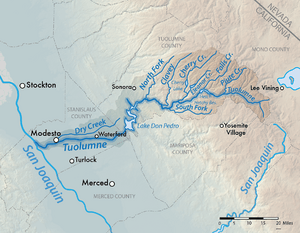Clavey River facts for kids
Quick facts for kids Clavey River |
|
|---|---|

Map of the Tuolumne River drainage basin, including the Clavey River
|
|
| Country | United States |
| State | California |
| Physical characteristics | |
| Main source | Sierra Nevada Stanislaus National Forest 5,989 ft (1,825 m) 38°08′28″N 119°58′02″W / 38.14111°N 119.96722°W |
| River mouth | Tuolumne River Above Lake Don Pedro 1,178 ft (359 m) 37°51′50″N 120°06′59″W / 37.86389°N 120.11639°W |
| Length | 31.3 mi (50.4 km) |
| Basin features | |
| Basin size | 157 sq mi (410 km2) |
The Clavey River is a cool river in the Sierra Nevada mountains of California. It flows into the Tuolumne River. The Clavey River is about 31.3 miles (50.4 km) (50.4 km) long. It is special because it is one of the few rivers in this area that does not have a dam. The Clavey River is part of the larger San Joaquin River system.
Contents
Where Does the Clavey River Flow?
The Clavey River starts in the Emigrant Wilderness. This area is part of the Stanislaus National Forest. It begins where two smaller streams, Bell Creek and Lily Creek, join together. This spot is about 3 miles (4.8 km) south of a town called Pinecrest.
River's Path and Tributaries
Most rivers in the western Sierra Nevada flow from east to west. But the Clavey River is different; it flows mostly from north to south. As it flows, other creeks join it. Rock Creek joins from the left side. Then Trout Creek joins from the right.
Further downstream, Twomile Creek and Cottonwood Creek add their waters from the right. Reed Creek, which is the biggest stream joining the Clavey, comes in from the left. This is about 15 miles (24 km) before the Clavey meets the Tuolumne River.
Journey to the Tuolumne River
The Clavey River also gets water from Bear Springs Creek and Quilty Creek. These join from the right side. After this, the river flows through a rough canyon. This part of the river is hard to reach without a boat.
About 5 miles (8.0 km) from where it meets the Tuolumne River, the Clavey makes a big turn to the west. The place where the Clavey River joins the Tuolumne River is famous. It has a thrilling rapid called Clavey Falls. This spot is about 11 miles (18 km) upstream from Lake Don Pedro.
What Makes the Clavey River Special?
The Clavey River has some really cool features.
Fun for River Adventurers
If you like rafting or kayaking, Clavey Falls is a famous spot. It offers an exciting challenge for people floating down the Tuolumne River. The Clavey River also has natural swimming holes. These are smooth, deep pools carved into the granite rocks by the water over many years. They are perfect for a swim on a hot day!
Home to Unique Wildlife
The Clavey River is very important for nature. It is one of the healthiest rivers in California. This means it has a great balance of plants, animals, and the environment. It is special because it is home to a unique type of coastal rainbow trout. These fish have lived here since before the last Ice Age!
Protecting the Clavey River
The Clavey River is one of the few rivers in California that has never been dammed. Many groups have tried to build dams on it, but so far, none have succeeded.
A group called the Clavey River Ecosystem Project (CREP) is working to keep the river healthy. They are studying the river to understand it better. Their goal is to make plans to protect the Clavey River for the future.

